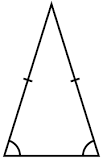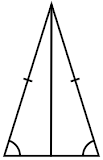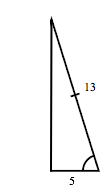An isosceles triangle has base 10 and perimeter 36? How would I find the area?
1 Answer
60
Explanation:
An isosceles triangle has two sides of equal length.

Our base is length 10 and our perimeter is length 36. The perimeter equals the length of the base plus the two sides. We can write a formula for that.
let's add values and solve
Great, so our base is length 10, and our two sides are length 13.
In order to solve for the area of the triangle, we need to use the following formula:
The area equals one half of the base, times the height.
We have the length of the base, but not the height. Let's draw a line down the center of our triangle. We need to know the length of that line.

Luckily, we've just created two right triangles. If we know the length of two sides of a right triangle we can solve for the third side with the pythagorean theorem.

Let's take a look at the right triangle. We know that it has a base of 5 because 5 is
Let's now solve for the third side with the pythagorean theorem.
Great! The remaining side of the triangle is length 12.
Now we know the height of our isosceles triangle is length 12.
We can plug that into our formula and solve:
That's it!

